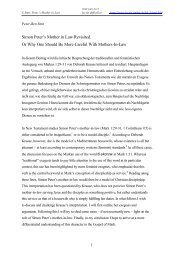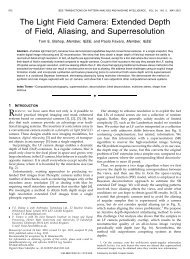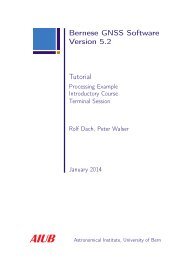Minimal Models of Adapted Neuronal Response to In Vivo–Like ...
Minimal Models of Adapted Neuronal Response to In Vivo–Like ...
Minimal Models of Adapted Neuronal Response to In Vivo–Like ...
You also want an ePaper? Increase the reach of your titles
YUMPU automatically turns print PDFs into web optimized ePapers that Google loves.
Adapting Rate <strong>Models</strong> 2117<br />
I ahp =−g N [N] i (see equation 2.1), and √ 2τ ′ is a fac<strong>to</strong>r <strong>to</strong> preserve units (see,<br />
e.g., Rauch et al., 2003). V rest = 0 is the resting potential, C is the capacitance<br />
<strong>of</strong> the membrane, τ = RC, and R is the membrane resistance. ξ t is a<br />
gaussian process with flat spectrum and unitary variance, 〈ξ t ξ t ′〉=δ(t − t ′ )<br />
(white noise; see, e.g., Tuckwell, 1988, or Gardiner, 1985, for more details).<br />
<strong>In</strong> a nonadapting neuron, I ahp ≡ 0. <strong>In</strong> the adapting threshold model (see section<br />
2.2), I ahp = 0 and the threshold θ ≥ θ 0 is a dynamical variable obeying<br />
equation 2.7.<br />
A.2 Quadratic <strong>In</strong>tegrate-and-Fire Neuron. The dimensionless variable<br />
V, <strong>to</strong> be interpreted as the membrane potential <strong>of</strong> the white noise–driven<br />
QIF neuron obeys<br />
τdV = (V 2 + µ)dt + σξ t<br />
√<br />
τdt,<br />
(A.2)<br />
where τ is a time constant that mimics the effect <strong>of</strong> the membrane time<br />
constant, and µ, σ 2 are the average and variance per unit time <strong>of</strong> the input<br />
current. A spike is said <strong>to</strong> occur whenever V =+∞, after which V is clamped<br />
<strong>to</strong> V =−∞for a refrac<strong>to</strong>ry period τ r . <strong>In</strong> practice, in the simulations, V is<br />
reset <strong>to</strong> −50 whenever V =+50. This gives an accurate approximation for<br />
the parameters chosen in Figure 2. On the other hand, in the rate function,<br />
equation 2.4, the actual values used for the integration limits do not matter,<br />
provided they are larger than +10 and smaller than −10 respectively.<br />
A.3 Conductance-Based LIF Neuron. The membrane potential <strong>of</strong> the<br />
conductance-based LIF neuron obeys<br />
dV =−˜g L (V − V rest )dt + g E (V E − V)dP E + g I (V I − V)dP I ,<br />
where g E,I = τ ḡ E,I /C are dimensionless peak conductances, ˜g L = 1/τ is the<br />
leak conductance in appropriate units (1/ms), V E,I are the excita<strong>to</strong>ry and<br />
inhibi<strong>to</strong>ry reversal potentials, and dP E,I = ∑ j δ(t − tE,I<br />
j<br />
)dt are Poisson spike<br />
trains<br />
√<br />
with intensity ν E,I . <strong>In</strong> the diffusion approximation (dP x → ν x dt +<br />
νx dtξ t ), the equation can be put in a form very similar <strong>to</strong> equation A.1 (see,<br />
e.g., Hanson & Tuckwell, 1983; Lánský &Lánská, 1987; Burkitt, 2001):<br />
dV =− V τ ∗ dt + µ 0dt + σ 0 (V) √ dtξ t<br />
(A.3)<br />
where<br />
µ 0 = ˜g L V rest + (g E V E ν E + g I V I ν I ) (A.4)<br />
σ0 2 (V) = g2 E (V E − V) 2 ν E + g 2 I (V I − V) 2 ν I<br />
(A.5)<br />
τ ∗ = ( ˜g L + g E ν E + g I ν I ) −1 .<br />
(A.6)
















